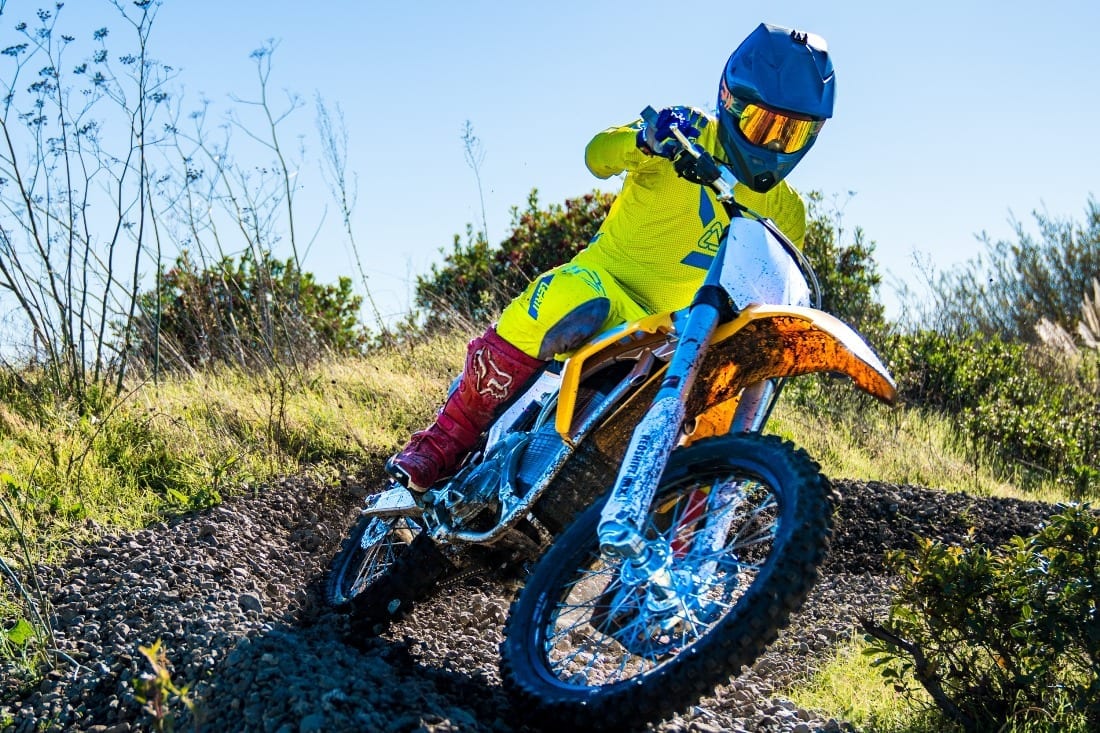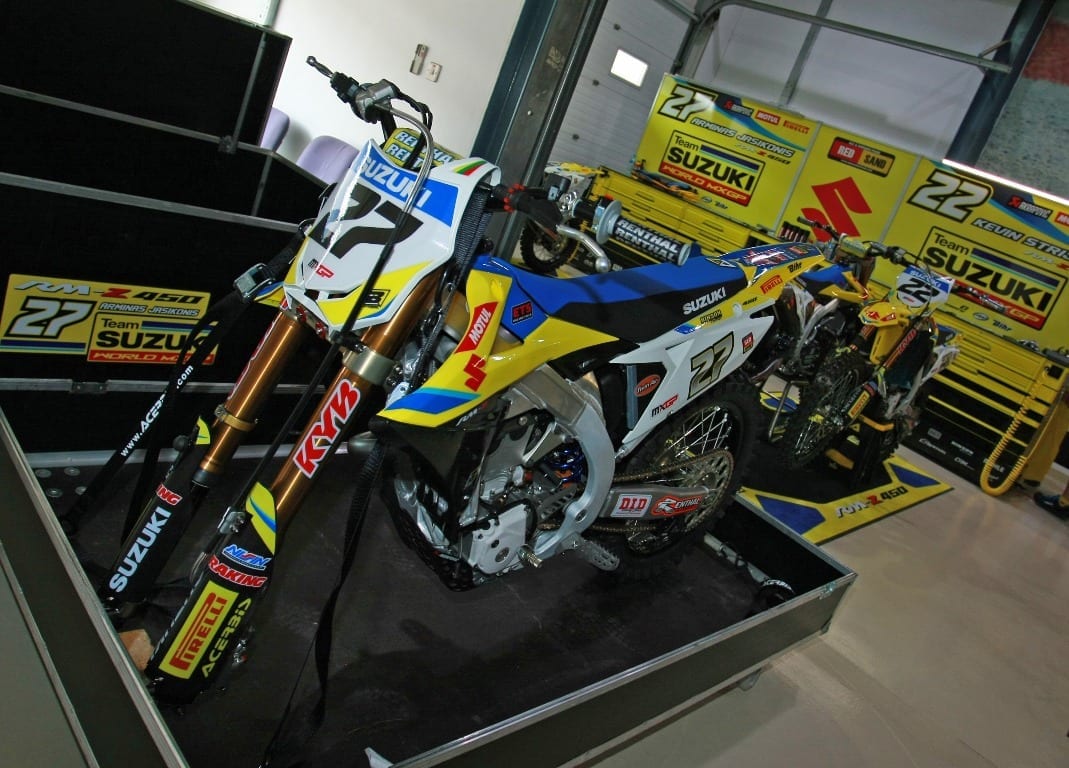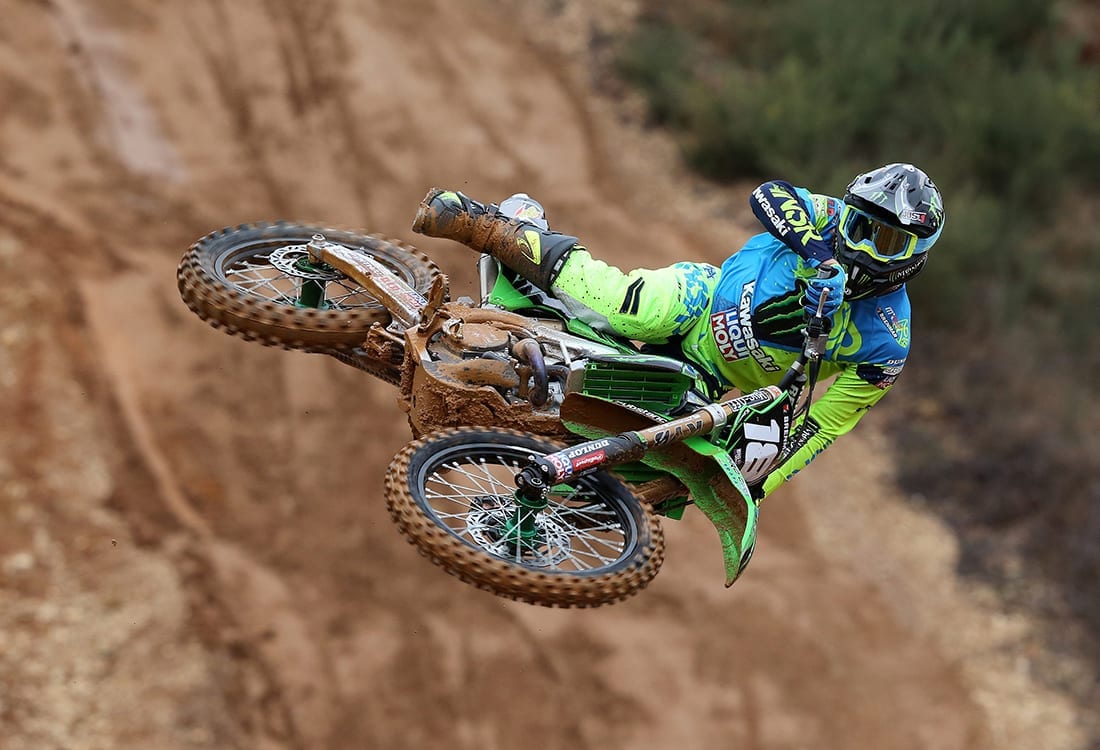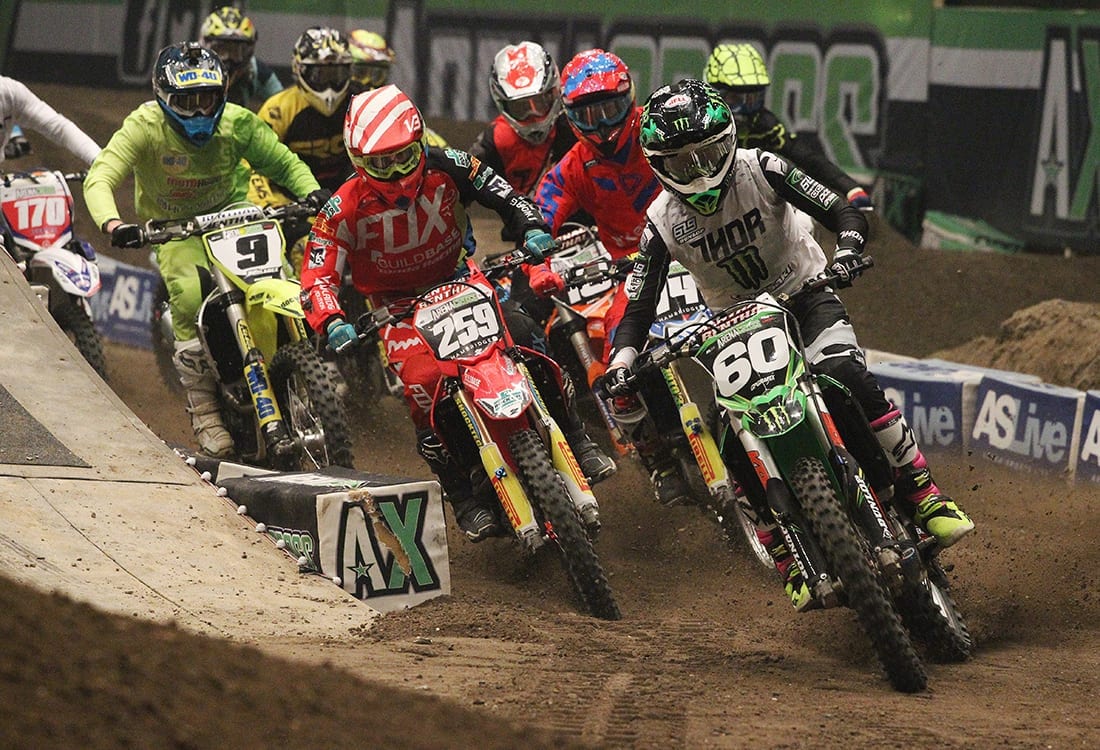Alta Motors Redshift MX - Fully charged
By TMX Archives on 23rd Feb 17

Alta Motors is making the headlines in all the right ways with the worlds first competitive electric motocross bike
Silicon Valley is a hub of innovation, a centre of technological advancement, a place where the future is created. Many of the world's leading tech companies choose to call it home - Apple, Google, Netflix, Facebook, YouTube, eBay and Tesla are just some of the big players based in the San Francisco Bay area.
Sillicon Valley companies have dramatically changed the way in which we live our lives and will continue to shape and influence our future and maybe - just maybe - one of them will have a part to play in the future of the motocross world...
The Alta Motors HQ is actually located just a little north of the technological hub and just a tad south of San Francisco itself in an ideal spot for this seriously cool young company.
"We have people here from Tesla and from Toyota," says Jon Bekefy, Alta's Director of Marketing. "We have self-made people and we have highly-educated employees. The team we have here is without doubt the best team I have ever worked with.
"Whether they ride or not these men and women get it. They are here late, they are cranking out the hours and the work. We chose to be based where we are, we've drawn from suppliers and manufacturers and from all this wealth of information that is all around us here. Our founders had a clear vision of what they wanted to do and this area has offered the bounty and the resources to be able to get that done."
Alta Motors specialises in the production of race-ready electric motorcycles and, after eight years of hard work and innovation, proved at Red Bull Straight Rhythm that the rest of us should start taking it seriously.
We visited Alta's HQ in Brisbane CA and sat down with co-founder and CTO Derek Dorresteyn to hear all about the origins of the company and, of course, to get our hands on the Redshift MX to have a play...
Alta's story
TMX: Tell us the Alta story, the background of the company and how this all got started...
Derek Dorresteyn: The seed of Alta was first planted after I was coming back from a supermoto test. We had hopped up the bike and in the process made it really peaky and not very fun to ride. I started talking to fellow co-founder Jeff Sand about the ability with an electric vehicle to do all of that tuning with software instead of cam shafts.
We talked about how it would be interesting to hit reset and try something new and different.
So we had that initial idea and eventually that blossomed into us realising that maybe the time is now to do this, maybe it has now become possible to build a competitive electric motorcycle.
We knew that the avenue had been explored in the past but the products had never really reached expectations.
For us it was never about if it was possible to build an electric motorcycle, it was about whether it was possible to build a better motorcycle using an electric drive chain.
I started building simulations on spreadsheets and looking at what parts were available to put something together. I found through my simulations that it was possible, however I found in the world of components that it wasn't possible - so that's what started us on the road of designing everything from scratch.
TMX: Can you talk about the early days of the company and the first few prototypes...
DD: The early days were very exciting but things weren't nearly as structured as they are now. Nowadays we have a lot of different disciplines and specialities under the roof but back when we started out it was only really four people. Out of those four we had experience in business, in engineering and in design.
We worked with a few outside folks on the electrical side of things and we had the first prototype done in about six months.
That first prototype did work pretty well. It didn't quite hit all the specs that we had set ourselves - it was a little heavier than we wanted it to be and it certainly wasn't very reliable - but it was functioning and we learned a lot in the process. We knew we had to make another one that fixed all the misses of the first as well as incorporating a bunch of new thinking and new technology.
It's been six years since we first became a California corporation but we've actually been at this for more like eight years. Those first two years were most certainly not a full-time effort - it was more of just a night and weekend hobby of ours.
TMX: What makes the Alta Redshift not only a better electric motorcycle but a better motocross bike in general?
DD: What makes the Redshift MX superior is the control that you have of traction, the control of the application of torque to the rear wheel, the lack of transmission and the lack of shifting, the fact that you're not chasing a torque curve - the motor makes peak torque at 0rpm so you always have peak torque available. When you combine all of that with a state-of-the-art chassis the ride quality is fundamentally different and better.
TMX: What's the top speed?
DD: The stock bike in motocross trim is geared to go about 70 mph.
TMX: And in terms of horse power?
DD: We are putting out around 40bhp at the wheel, 36ft lbs of torque at the motor which equates to about 125ft lbs of torque at the countershaft sprocket and then somewhere around 500ft lbs of torque at the wheel.
TMX: What's the cost of one of these machines?
DD: The Alta Redshift MX retails for $14,995. It comes with an off-board charger that is capable of charging the bike from zero in around two-and-a-half hours.
TMX: And what about the battery life?
DD: The range is completely dependent on the use. We've engineered the bike to do 30 minutes plus two laps on the motocross track with a pro rider, that translates to about 45-50 minutes - or sometimes more -when in the hands of an intermediate rider and if you take it trail riding where the speeds are lower we regularly go two-and-a-half to three hours. The record is five hours of riding on slow, technical trails.
TMX: Can you talk us through the technology?
DD: Our chassis and the ergonomics of our bike are really the same to what people are familiar with. The weight balance front to rear, the stiffness of the chassis and all of that stuff is completely familiar to anyone that hops on our bike. Where the differences start to come in is in the drive train and how the throttle is connected to the rear wheel.
Obviously we do not have an internal combustion engine and we also don't have a gearbox or a selectable gearbox, we have a gear reduction. So you basically start off in sixth gear and you ride around in sixth gear all the time - you never shift.
The electric motor produces an incredible amount of torque and through the gear reduction and the final drive reduction we have about a 14-and-a-half to one gear reduction. So the torque that is at the rear tyre is really that sweet spot of torque that you get when you are in second gear and the front wheel is light and you can really squirt out of the corner.
With our motor you're in that moment all the time and that's really magical you know. That's a brief explanation of what's happening between the motor and the rear wheel.
The battery is actually a collection of smaller batteries that are put together to form a pack - we have a lot of product development, engineering and technology in that system. Our battery, to our knowledge, is the highest energy per pound in transportation.
It's a very sophisticated system, it has a lot of built-in safety and a lot of built-in checks - things that keep the cells cool, things that monitor their voltage relative to each other and things that keep everything working in a safe way at its optimum output of power and energy. That's a DC battery running at a nominal of 300 volts and that's connected to the motor control.
Now the motor control is a pretty sophisticated device, it takes that DC energy and through a series of switches and a technique called pulse width modulation it turns that DC into three phases of AC and that's what is spinning the motor. The motor is a three-phase AC synchronous motor with permanent magnets in it. The permanent magnets allow the motor to get very high torque density and the AC allows us to run very efficiently over a torque speed range. The magic is really in the software that is controlling that motor control.
Between the throttle signal and the rear wheel it's that software and how it turns that DC power into AC power at various frequencies. So you've got speed and torque being controlled - the throttle is actually a direct torque control but speed is also a function.
There's a lot of magic in how the bike feels in low traction situations, off jumps and accelerating out of corners. We've literally put hundreds of hours into testing and refining that.
The verdict is that it feels amazing and the bike is very responsive. It behaves very similarly to the internal combustion engine - you have that same control in the air to change the attitude of the bike, the responsiveness is there and I guess the proof of that for us came at Straight Rhythm and particularly Josh Hill's performance through the whoops.
That's technically the hardest thing to do and in my mind we were doing that better than anyone else.
TMX: When can we expect the bikes to arrive in the UK?
DD: We haven't nailed down exactly when we are going to enter the UK market but we will begin shipping bikes into Europe in the second quarter of 2017.
TMX: What does the future hold for Alta?
DD: We just started shipping bikes to customers in August. We've got a huge backlog of orders and we are going to be working pretty much halfway through next year filling that backlog which is an exciting thing for us. And, of course, we are going to do more racing.
Racing is the finest showcase that there is. There's no denying when something is good or bad, it's all about the results. Obviously we did Straight Rhythm this year, we did three [endurocross] events with Kurt Nicoll riding in the Vet class - we won the first round, came second in the second one and second in the third.
We are also working really hard to be allowed to race in some of the more prestigious motocross and supercross races. Currently we are written out of the rules so we also have our sights set on some of the other events that we are allowed to race in such as AMA supermoto, some of the amateur racing at Loretta's and Mammoth as well as various flat track events which we are also allowed to race in.
TMX: Is the future electric?
DD: I think the electric motocross bike is part of the future of the sport. We are not here to take anything away from anybody or take any product's place out there. We are just here to make a better motorcycle and if we can continue to do that we may see more Altas out there than we do now and in my book that's success for us.
First test - ridden, ragged and rated
I was able to take out a Redshift MX that had literally just come off the production line and give it a maiden voyage. We rode our silent assassins through the streets before taking them off-road at Alta's very own backyard playground.
During that short journey I took my time getting accustomed to the lack of noise as well as to the lack of clutch and gears. It was definitely very peculiar to begin with.
However, I must say that feeling didn't last all too long once we made it to the track.
Now I'm not going to lie, my first few laps of the tight and technical turn track were littered with brain fart moments when I was convinced I had stalled the bike while braking hard into the corners. But that's just not possible on the Alta Redshift MX. The lack of engine noise was simply playing tricks on me.
After a while I learnt to read the silence and listen to the soft whine of the electric motor - plus the sounds of my awesome skids!
The Alta Redshift MX is the equivalent of a 250F four-stroke. Because of the weight of the batteries it's actually heavier than a conventional MX2 machine but I really didn't notice this on track. The bike didn't feel heavy whatsoever - in fact the Redshift felt very agile, nimble and incredibly easy to manoeuvre.
The only situation in which I noticed that the bike felt heavy was when I was picking it up from the ground. And no, I didn't drop it or crash it - because there's no engine fluids or oils or petrol or anything like that it's totally acceptable to lay your bike down on the ground when you take a break.
In terms of power and performance I was once again genuinely shocked at what the Alta is capable of. The Redshift comes with four pre-programmed map settings to switch between when you're on the go. To start I was in map setting one.
The power came in very smoothly - to be honest I was expecting it to be a little punchier as I had heard about the instant torque from an electric motor.
It wasn't until I switched it to map setting four that I truly realised what people were talking about. The power was put to the ground instantly. It was a little wet and slick in places so it was a job in itself controlling the back end coming out of the turns.
Because this is an electric motor you're not chasing any kind of torque curve, she just pulls and pulls and pulls. It was pretty amazing. When I found some open space and a long straight I opened her up to see what she had and boy did it feel like I was going fast.
It's worth noting that there is no gearbox and no shifting. This was definitely a little strange and some people may say that it takes some of the fun or some of the challenge out of the ride. Well I didn't feel that way on the day.
The lack of shifting allowed me to focus solely on my body positioning and technique when manoeuvring the tight and twisty corners of the track. It was definitely a good training method.
Overall I thought the bike handled pretty great. It felt very planted in the turns which inspired a lot of confidence and spurred me on to push harder and harder and lean it over further and further each time around. I think the best compliment I can give to the chassis and to the bike as a whole is that it really did feel just like a motocross machine.
I felt as though I could've been riding any other brand of dirt bike, it just so happened that this one was yellow and had an electric motor.
The bike was very user-friendly. It has a three-stage start-up procedure - a turn of a key and two buttons to press - that was very easy to pick up.
The dash was nice and simple with a clear battery power indicator as well as mileage and speed.
One of the only negatives is the overall battery life.
I spent about an hour messing around on the bike before the battery started getting low and we had to call it a day which was a shame because I was having loads of fun. However, I suppose longer life that would come at the cost of more weight or less power.
The other major hurdle in the way of the Alta Redshift is the lack of brap and the missing smell of an internal combustion engine - things I think a lot of people will find hard to get over.
Is this the future? I'm not too sure but just think of the opportunities that silent electric motorcycles could open up - inner city racing, more tracks and less hassle and conflict with the wider world. The electric avenue most certainly has its advantages.
Now that I've ridden the Alta Redshift I can rest easy in knowing that if one day we can no longer shred our beloved fossil fuel-burning dirt scooters we still have the Alta to save us - and I'm just fine with that!
Developing the Alta
Kurt Nicoll and Josh Hill have helped develop the bike and raise the company's profile but the testing and development programme was already well under way before the pair came on board.
"It started with Dennis Stapleton and Kris Keefer," explains Bekefy. "Those guys are killer riders but also great test and development riders too. This company has always endeavoured to put the best foot forward in terms of competition and development and having Stapleton and Keefer helped us to do that.
"And now this next wave - Nicoll and Hill - and we even go up to Oregon to race flat track with Andy DiBrino.
We come home with a ton of set-up data, settings for the chassis and the map tuning. Because of that we know how to race short track, we know how to put together a power package and maps that work on clay, we know suspension settings from an event like Straight Rhythm if we were going to race a supercross.
"Kurt has given us a ton of feedback on endurocross and how to build the bike and the maps to allow him to be successful and help earn him every little advantage that he can gain out of the bike.
"So this development process is two-fold. We develop the bikes to enable these guys to be successful in their racing and to cater these bikes and the packages to their tastes.
"At the same time it is very beneficial for us that they do well and that they are good at development but we also get to come home with a ton of data for our production bikes, we get to form new relationships with companies like WP, we get new map settings and we gain an understanding on how to tailor these packages. Development with these guys is key."
Straight to the point
Alta's enjoyed some great exposure this year with Josh Hill racing one to fourth at Red Bull Straight Rhythm and Kurt Nicoll enjoying considerable success in endurocross.
"Straight Rhythm was a big day for us," says Dorresteyn. "Our goal had really been to just be included in the event and to not suck and I think we did a lot more than just not sucking.
"We had been notified that we were eligible to race the event about six or eight weeks beforehand. We had been doing some testing with Josh Hill before that. We really liked Josh so I proposed that we do a test to determine if we thought we would be competitive and whether we should give it a shot.
"We did the test at one of the qualifier tracks - the bike performed pretty well but we knew we had a lot more work to do to really be competitive. Josh signed on at that point, it was probably four weeks before the event."
Getting the bike race-ready for an event like Straight Rhythm required a huge team effort.
"We did more test days out at Pala on the week of the event, mostly just working on suspension settings.
At that point we hadn't really done any development for supercross suspension settings so that was an eye-opening week for our technical team.
"We got a lot of help from WP - we got A-kit suspension on the bike and tested a lot of new settings. The electric bike delivers power in a different way and requires different suspension settings compared to the gas bikes."
Despite the intensive testing programme the Alta team still weren't sure how the bike would perform.
"We had a lot of faith in the bike and in our technical team to make a lot of changes in the software and alter how the bike was reacting and behaving on the track. We continued to make subtle changes to the software throughout the day and by the time the races came we weren't really sure how we would do.
"We knew that we had qualified slightly slower than the other rider in our first match-up but we were still tweaking stuff and Josh was still getting up to speed. We won the first one, lost the second one and then we won the third race progressing us into the next round.
"That was a huge moment that exceeded everyone's true expectations of that night. We actually brought it home as far as the team was concerned."


